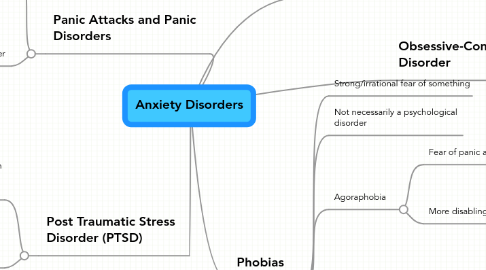
1. Panic Attacks and Panic Disorders
1.1. Panic Attack
1.1.1. sudden episode of extreme anxiety that rapidly escalates in intensity
1.2. Panic Disorder
1.2.1. panic attacks occur frequently and unexpectedly
1.2.2. Explanation
1.2.2.1. Possibly Genetic
1.2.2.2. Unusually sensitive to signs of physical arousal
1.2.2.3. People misinterpret physical signs of arousal as catastrophic and dangerous
2. Post Traumatic Stress Disorder (PTSD)
2.1. Long lasting anxiety disorder that develops in response to an extreme physical or psychological trama
2.2. Symptoms
2.2.1. Frequently recall the event
2.2.2. Avoid stimuli that trigger memories of the experience
2.2.3. Increased physical arousal associated with anxiety
3. Generalized Anxiety Disorder (GAD)
3.1. Global, persistent, chronic, and excessive apprehension
4. Phobias
4.1. Strong/irrational fear of something
4.2. Not necessarily a psychological disorder
4.3. Agoraphobia
4.3.1. Fear of panic attacks in public places
4.3.2. More disabling than specific phobias
4.3.2.1. Avoid situations where a panic attack may be provoked
4.3.2.2. Avoid situations where they would be unable to escape should an attack occur
4.4. Social Phobia
4.4.1. Fear of social situations
4.4.1.1. Fear of being embarrased or failing in public significantly interferes with daily life
4.5. Explanation
4.5.1. Classical Conditioning
4.5.1.1. Becoming phobic of something due to a fearful situation you were once in
4.5.2. Operant conditioning
4.5.2.1. Reducing anxiety by avoiding the situation reinforces the phobia
4.5.3. Observational learning
4.5.3.1. learn to be phobic by observing fearful reactions of someone else who acts as a model
5. Obsessive-Compulsive Disorder
5.1. Life is dominated by repetitive thoughts and behaviors
5.1.1. Obsessions
5.1.1.1. repeated, intrusive, uncontrollable thoughts or mental images that cause the person great anxiety and distress
5.1.2. Compulsion
5.1.2.1. repetetive behavior that a person feels driven to perform
5.2. Explanations
5.2.1. A deficiency in the neurotransmitter serotonin has been implicated in obsessive-compulsive disorder
5.2.2. Dysfunction in specific brain areas
